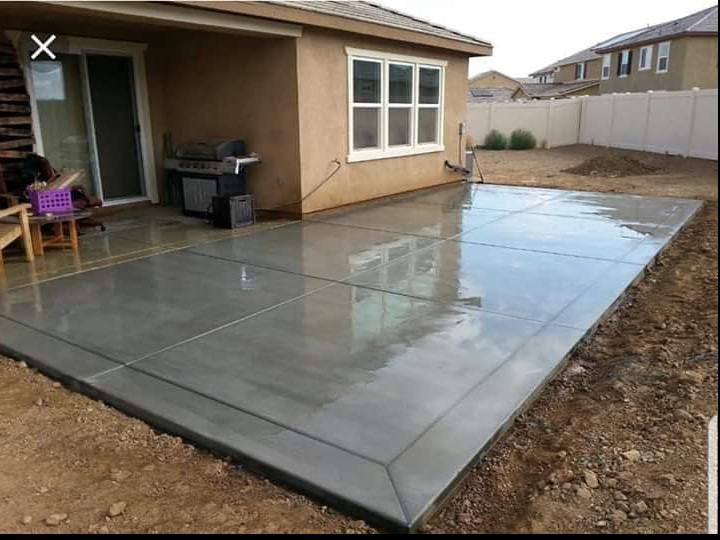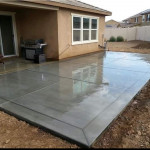WHAT TEMPERATURE SHOULD YOU POUR CONCRETE?

Concrete should be poured at a temperature between 50 and 80 degrees Fahrenheit. This is because concrete gains its strength and durability through a process known as hydration, which can be affected by extreme heat or cold. There are other methods that can be used when the temperature is outside of this range.
How Concrete Works
To understand why the proper temperature is so important when pouring concrete, you must first understand how concrete works.
Concrete is a recipe with two main "ingredients": aggregate and paste. The aggregate is a combination of both sand and broken gravel in the proper proportions. The paste is a mixture of cement and water (cement is a fine powder that has several elements, such as ash, finely ground stone, and other minerals)
When the aggregate and paste are mixed, they form a gooey substance that can be poured and formed into various shapes and molds. However, if this substance is left alone for an extended period, it begins to harden. It eventually solidifies to the point where it resembles rock.
The Importance of Hydration
Even after it has set, concrete gains strength through the hydration process (aka "curing"). The compounds in the cement mixture react chemically with the water molecules in the concrete.
Because of these chemical reactions, cement particles join together, resulting in a stronger, more cohesive substance.
While the concrete will harden relatively quickly after the initial pour, the hydration process will continue for weeks, if not months. That is why experts claim that concrete gets stronger over time. However, if the concrete is poured or cured in extremely hot conditions, the hydration process may not function properly.
Why it's Important to Maintain the Right Temperature
The first 72 hours after the initial pour are the most critical in the hydration process. Heat - or the lack of it - influences the chemical reaction in which water molecules help to bind cement particles together. This means that pouring concrete during the summer or winter may present additional challenges.
The Risks of Pouring Concrete at an Inappropriate Temperature
Due to evaporation, pouring concrete in hot weather can reduce the volume of water in the concrete mixture. This can result in shape abnormalities, but it can also weaken the final product, putting the concrete at risk of chipping, flaking, and cracking under pressure.
However, the curing process will take much longer if the concrete mixture is poured when it is too cold outside. While this may not appear to be a big deal at first, the potential consequences are hard to ignore. Slow curing concrete tends to shift over time, causing severe structural damage to any buildings or materials that are supported. Freezing temperatures can also cause water in concrete to freeze and expand, causing the concrete to break. These breaks may be noticeable, or they may form in the middle of the concrete, going unnoticed until a heavy structure is placed on top of it, causing it to crumble.
The Ideal Temperature for Pouring Concrete
To avoid these problems, pour concrete at temperatures ranging from 50 to 60°F. Temperatures below 50°F begin to slow the curing process, and temperatures below 40°F risk freezing the water in the cement.
If the temperature rises above 60°F, the water in the concrete may begin to evaporate while it cures, affecting the structural integrity of the poured concrete; however, this effect can be mitigated by regularly watering the concrete after it has hardened. Spray the concrete 5 to 10 times daily for the first 72 hours to help the curing process with additional hydration. Remember that concrete should not be sprayed until it has hardened, which takes 4 to 8 hours.
The Best Season for Pouring Concrete
While summer may appear to be an appropriate time for these projects, the constant heat can become an issue, given that the ideal temperature for pouring concrete is between 50 and 80°F. As a result, the best time to pour concrete is during the cool to moderate months of the year.
Depending on where you reside, this could be spring, fall, or even winter for those who reside in very warm climates. Ideally, the temperature should remain between 50 and 80 degrees Fahrenheit for most of the day. Also, ensure that nighttime temperatures do not fall below 40°F, as this may cause the water in the concrete to freeze, increasing the risk of chipping and breaking.
Work with the Best Concrete Contractors in Omaha, NE
It takes skill, knowledge, and experience to lay concrete in ideal weather conditions. Our concrete professionals at Omaha Concrete and Paving have years of training and experience and know how to complete a concrete pour regardless of how hot or cold it is.































